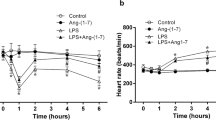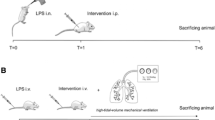Abstract
The inhibitory effects of YM264, a selective platelet activating factor (PAF) receptor antagonist, and 2-(3-methylsulfonylamino-2-oxo-6-phenyl-1,2-dihydro-1-pyridyl)-N-(3,3,3-trifluoro-1-isopropyl-2-oxopropyl)acetamide (compound 1), a neutrophil elastase inhibitor, on mortality, and pancreatic, hepatic, renal and pulmonary dysfunction were evaluated in a rat model of multiple organ failure (MOF) accompanying acute pancreatitis. MOF was produced by intraperitoneal injection of lipopolysaccharide (LPS, 30 mg/kg) in rats with cerulein-induced pancreatitis. LPS dose-dependently increased the mortality in rats with or without pancreatitis. The threshold dose which produced death in rats without pancreatitis was 30 mg/kg. This same dose evoked death in more than 40% of rats with pancreatitis. Time-course changes in serum enzyme and organ myeloperoxidase (MPO) levels were first examined in rats with induced MOF, and the results were compared with those in rats treated with only LPS or cerulein. Pancreatic weight, and serum amylase and lipase levels significantly increased in rats with cerulein-induced pancreatitis despite the presence or absence of LPS, but recovery of these pancreatic dysfunctions was slower in the group given LPS. However, serum GOT, GPT, BUN and creatinine levels were significantly elevated only in MOF rats. In the MOF rats, the MPO level in the lung was significantly elevated and arterial oxygen pressure was decreased, indicating that infiltration of neutrophils into the lung might be involved in pulmonary dysfunction. However, the MPO levels in the pancreas and kidney in the MOF rats were not remarkably different from those in normal rats. The inhibitory effects of YM264 and compound 1 on mortality and organ dysfunction were examined in this MOF model. The 24-h survival rate for rats prophylactically and therapeutically treated with an intravenous infusion of YM264 at 0.1 mg/kg h was significantly higher than that of controls. The 24-h survival rate for rats treated prophylactically by intravenous infusion of 2 mg/kg h of compound 1 was significantly higher than that of control, whereas a beneficial dose of compound 1 was 5 mg/kg h in therapeutically treated rats. Prophylactic treatment with YM264 (0.1 mg/kg h) and compound 1 (2 mg/kg h) ameliorated organ dysfunction in rats with MOF. In conclusion, pancreatic, hepatic, renal and pulmonary dysfunctions are observed in this rat MOF model. The PAF receptor antagonist and neutrophil elastase inhibitor reduce the mortality rate in rats with MOF due to their inhibitory effects on organ dysfunction, indicating that PAF and neutrophil elastase may play important roles in the development of MOF. These results in the present model are largely consistent with those in patients with MOF, indicating that this model is suited for MOF in humans and may be used as a model to test new therapeutic approaches.
Similar content being viewed by others
Author information
Authors and Affiliations
Additional information
Received: 22 December 1997 / Accepted: 6 April 1998
Rights and permissions
About this article
Cite this article
Yamano, M., Umeda, M., Miyata, K. et al. Protective effects of a PAF receptor antagonist and a neutrophil elastase inhibitor on multiple organ failure induced by cerulein plus lipopolysaccharide in rats. Naunyn-Schmiedeberg's Arch Pharmacol 358, 253–263 (1998). https://doi.org/10.1007/PL00005250
Issue Date:
DOI: https://doi.org/10.1007/PL00005250




